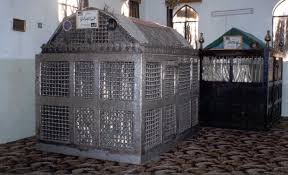Zarih on:
[Wikipedia]
[Google]
[Amazon]

 A zarih ( hi, ज़रीह) or ḍarīḥ ( ar, ضَرِیح) is an ornate, usually gilded, lattice structure, that encloses a grave in a
A zarih ( hi, ज़रीह) or ḍarīḥ ( ar, ضَرِیح) is an ornate, usually gilded, lattice structure, that encloses a grave in a 

 A zarih ( hi, ज़रीह) or ḍarīḥ ( ar, ضَرِیح) is an ornate, usually gilded, lattice structure, that encloses a grave in a
A zarih ( hi, ज़रीह) or ḍarīḥ ( ar, ضَرِیح) is an ornate, usually gilded, lattice structure, that encloses a grave in a mosque
A mosque (; from ar, مَسْجِد, masjid, ; literally "place of ritual prostration"), also called masjid, is a place of prayer for Muslims. Mosques are usually covered buildings, but can be any place where prayers ( sujud) are performed, ...
or Islamic shrine.
Zarihs serve as a marker for the tombs of religious figures, and as a symbol of their sacred nature. Zarihs are funded by donations, it is considered a blessing to do so, according to Shia. The construction and installation of zarihs are often done on a volunteer basis, made as a waqf
A waqf ( ar, وَقْف; ), also known as hubous () or '' mortmain'' property is an inalienable charitable endowment under Islamic law. It typically involves donating a building, plot of land or other assets for Muslim religious or charitabl ...
with its creators demanding no pay for their work.
A zarih is built from fine materials by skilled craftsmen, calligraphers, metal workers, jewellers, carpenters, and engineers. Zarihs can be the size of a small room and are commonly built by hand in a process that often takes several years. Not all zarihs are of the same quality; however, the most intricate zarihs found, are often in the shrines of Shia Imams
In Shia Islam, the Imamah ( ar, إمامة) is a doctrine which asserts that certain individuals from the lineage of the Islamic prophet Muhammad are to be accepted as leaders and guides of the ummah after the death of Muhammad. Imamah further ...
and are seldom built, these zarihs take longer to construct and use more sophisticated materials and methods.
The walls of a zarih are filled with verses from the Quran
The Quran (, ; Standard Arabic: , Classical Arabic, Quranic Arabic: , , 'the recitation'), also romanized Qur'an or Koran, is the central religious text of Islam, believed by Muslims to be a revelation in Islam, revelation from God in Islam, ...
, names of holy figures and other religious artwork. Notable installations are found in the Imam Husayn Shrine
The Imam Husayn Shrine ( ar, مَقَام ٱلْإِمَام ٱلْحُسَيْن ٱبْن عَلِيّ, Maqām al-ʾImām al-Ḥusayn ʾibn ʿAlī) is the mosque and burial site of Husayn ibn Ali, the third Imam of Shia Islam, in the city of ...
, the Al Abbas Mosque
, native_name_lang = ara
, image = Al Abbas Mosque, Shrine Karbala.jpg
, alt =
, caption =
, map_type = Iraq
, map_size =
, map_alt =
, map_relie ...
, the Sayyidah Ruqayya Mosque , the Abdul Qadir Jilani
ʿAbdul Qādir Gīlānī, ( ar, عبدالقادر الجيلاني, ʿAbd al-Qādir al-Jīlānī; fa, ) known by admirers as Muḥyī l-Dīn Abū Muḥammad b. Abū Sāliḥ ʿAbd al-Qādir al-Jīlānī al-Baḡdādī al-Ḥasanī al-Ḥusayn ...
Mosque, The Junaid Baghdadi
Junayd of Baghdad (; 830–910) was a Persian mystic and one of the most famous of the early Islamic saints. He is a central figure in the spiritual lineage of many Sufi orders.
Junayd taught in Baghdad throughout his lifetime and was an impo ...
with Sirri Saqti
Abū al-Ḥasan Sarī (al-Sirrī) b. al-Mughallis al-Saqaṭī (867CE) also known as Sirri Saqti (Arabic:سری سقطی) was one of the early Muslim Sufi saints of Baghdad. He was one of the most influential students of Maruf Karkhi and one o ...
shrine and the Imam Ali Mosque
The Sanctuary of Imām 'Alī ( ar, حَرَم ٱلْإِمَام عَلِيّ , Ḥaram al-ʾImām ʿAlī), also known as the Mosque of 'Alī ( ar, مَسْجِد عَلِيّ, Masjid ʿAlī), located in Najaf, Iraq, is a mosque which many Musl ...
.

See also
*Islamic architecture
Islamic architecture comprises the architectural styles of buildings associated with Islam. It encompasses both secular and religious styles from the early history of Islam to the present day. The Islamic world encompasses a wide geographic ar ...
* Shia
Shīʿa Islam or Shīʿīsm is the second-largest Islamic schools and branches, branch of Islam. It holds that the Prophets and messengers in Islam, Islamic prophet Muhammad in Islam, Muhammad designated Ali, ʿAlī ibn Abī Ṭālib as his S ...
* Sufi
Sufism ( ar, ''aṣ-ṣūfiyya''), also known as Tasawwuf ( ''at-taṣawwuf''), is a mystic body of religious practice, found mainly within Sunni Islam but also within Shia Islam, which is characterized by a focus on Islamic spirituality, ...
References
{{Mosques in Iraq Islamic architectural elements Mosque architecture Safavid architecture Shia shrines Islamic terminology